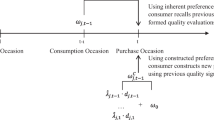Abstract
Brand loyalty consists of a consumer’s commitment to repurchase or otherwise continue using a given brand and is demonstrated by repeated buying of a product or service, or other positive behaviours such as word of mouth advocacy.Standard models of the emergence of brand loyalty consider the behaviour of autonomous individuals who are essentially reacting to the objective attributes of the brand. Here, we show that brand loyalty can be regarded as a social construct, which emerges when the fundamental psychological principle of self-image is combined with agents reacting to each others’ decisions in social network markets. Brand loyalty can emerge even when agents find it hard to distinguish between brands in terms of their objective attributes. We illustrate the principles in the context of the well-known model of binary choice with externalities. We endogenise the behaviour of agents using the principle of self-image, and illustrate the consequences in situations where consumers face not a one-off choice of adopting or not adopting, but a chain of mutually dependent decisions about complex products over a period of time.
Access this chapter
Tax calculation will be finalised at checkout
Purchases are for personal use only
Preview
Unable to display preview. Download preview PDF.
Similar content being viewed by others
References
Aaker, D.: Managing Brand Equity: Capitalizing on the Value of a Brand Name. Free Press, New York (1991)
Dyson, P., Farr, A., Hollis, N.: Understanding, Measuring, and Using Brand Equity. Journal of Advertising Research 36(6), 9–21 (1996)
Simon, H.A.: A behavioral model of rational choice. Quarterly Journal of Economics 69, 99–118 (1955)
Hauser, J.: A marketing science perspective on recognition-based heuristics (and the fast-and-frugal paradigm). Judgement and Decision Making 6, 396–408 (2011)
Dunbar, R.I.M., Shultz, S.: Evolution in the social brain. Science 317, 45, 1344–1347 (2007)
Schelling, T.C.: Hockey Helmets, Concealed Weapons, and Daylight Saving: A Study of Binary Choices with Externalities. Journal of Conflict Resolution 17, 381–428 (1973)
Meyers, R.: Psychology. Pearson, Boston (2010)
Sedikides, C., Spencer, S. (eds.): The Self. Psychology Press, New York (2007)
Tesser, A., Campbell, J.: Self-definition and self-evaluation maintenance. In: Suls, J., Greenwald, A. (eds.) Social Psychological Perspectives on the Self, vol. 2, pp. 1–31. Erlbaum, Hillsdale (1983)
Steele, C.M.: A Threat in the Air: How Stereotypes Shape the Intellectual Identities and Performance of Women and African-Americans. American Psychologist 52, 613–629 (1997)
Martin, L., Tesser, A. (eds.): Striving and feeling: interactions among goals, affect, and self-regulation. Erlbaum, Mawah (1988)
Festinger, L.: A Theory of Cognitive Dissonance. Stanford University Press, Stanford (1957)
Aronson, E.: The Theory of Cognitive Dissonance: A Current Perspective. In: Berkowitz, L. (ed.) Advances in Experimental Social Psychology, vol. 4, pp. 1–34. Academic Press, New York (1969)
Swann, W.B.: Self-verification: Bringing Social Reality into Harmony with the Self. In: Suls, J., Greenwald, A.G. (eds.) Psychological Perspectives on the Self, vol. 2, pp. 33–66. Erlbaum, Hillsdale (1983)
Bem, D.: Self-perception theory. In: Advances in Experimental Social Psychology, pp. 2–57 (1972)
Watts, D.J.: A Simple Model of Global Cascades on Random Networks. Proceedings of the National Academy 99, 5766–5771 (2002)
Nowak, A., Ormerod, P., Borkowski, W.: Cascades on Economic Networks with Endogenous, Evolving Agent Behavior, University of Warsaw, mimeo (2012)
Potts, J., Hartley, J., Cunningham, S., Ormerod, P.: Social network markets: a new definition of the cultural and creative industries. Journal of Cultural Economics 32, 167–185 (2008)
Author information
Authors and Affiliations
Editor information
Editors and Affiliations
Rights and permissions
Copyright information
© 2013 ICST Institute for Computer Science, Social Informatics and Telecommunications Engineering
About this paper
Cite this paper
Nowak, A., Ormerod, P., Borkowski, W. (2013). Self-image and the Emergence of Brand Loyalty in Networked Markets. In: Glass, K., Colbaugh, R., Ormerod, P., Tsao, J. (eds) Complex Sciences. Complex 2012. Lecture Notes of the Institute for Computer Sciences, Social Informatics and Telecommunications Engineering, vol 126. Springer, Cham. https://doi.org/10.1007/978-3-319-03473-7_25
Download citation
DOI: https://doi.org/10.1007/978-3-319-03473-7_25
Publisher Name: Springer, Cham
Print ISBN: 978-3-319-03472-0
Online ISBN: 978-3-319-03473-7
eBook Packages: Computer ScienceComputer Science (R0)




